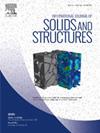Symmetry breaking and dynamic characteristics of post-buckling in bilayer van der Waals structures
IF 3.4
3区 工程技术
Q1 MECHANICS
International Journal of Solids and Structures
Pub Date : 2024-12-09
DOI:10.1016/j.ijsolstr.2024.113190
引用次数: 0
Abstract
The van der Waals (vdW) interaction plays a crucial role in the mechanical properties, including bending and buckling, of layered 2D materials, directly affecting their performance as flexible devices. This study systematically investigates the symmetry breaking and dynamic characteristics of post-buckling in bilayer vdW structures caused by the local atomic positions’ dependence of vdW interactions. Our observations reveal that the buckling configuration of bilayer molybdenum disulfide (MoS2) exhibits a significant dependence on the direction of applied load. When compressed along the zigzag direction, the post-buckling configuration is symmetric. In contrast, compression along the armchair direction results in a significant asymmetric post-buckling configuration. Additionally, the asymmetric buckling configuration strongly correlates with the length of the structure and the magnitude of compressive strain. Combining molecular dynamics simulations and a continuum-discrete model, it is found that this symmetry breaking in buckling results from anisotropic and non-uniform shear and sliding between atomic layers. Moreover, under biaxial compression, bilayer circular MoS2 demonstrates post-buckling configurations and thermal vibration modes markedly distinct from monolayer MoS2. These configurations are closely associated with the initial stacking orders of bilayer MoS2. In particular, effective modulation of asymmetry is achieved by twisting the bilayer structure, offering insights into controlling buckling behavior. These findings provide novel perspectives for describing and addressing buckling issues in layered vdW structures and offer guidance for designing and optimizing vdW structure devices.
求助全文
约1分钟内获得全文
求助全文
来源期刊
CiteScore
6.70
自引率
8.30%
发文量
405
审稿时长
70 days
期刊介绍:
The International Journal of Solids and Structures has as its objective the publication and dissemination of original research in Mechanics of Solids and Structures as a field of Applied Science and Engineering. It fosters thus the exchange of ideas among workers in different parts of the world and also among workers who emphasize different aspects of the foundations and applications of the field.
Standing as it does at the cross-roads of Materials Science, Life Sciences, Mathematics, Physics and Engineering Design, the Mechanics of Solids and Structures is experiencing considerable growth as a result of recent technological advances. The Journal, by providing an international medium of communication, is encouraging this growth and is encompassing all aspects of the field from the more classical problems of structural analysis to mechanics of solids continually interacting with other media and including fracture, flow, wave propagation, heat transfer, thermal effects in solids, optimum design methods, model analysis, structural topology and numerical techniques. Interest extends to both inorganic and organic solids and structures.

 求助内容:
求助内容: 应助结果提醒方式:
应助结果提醒方式:


